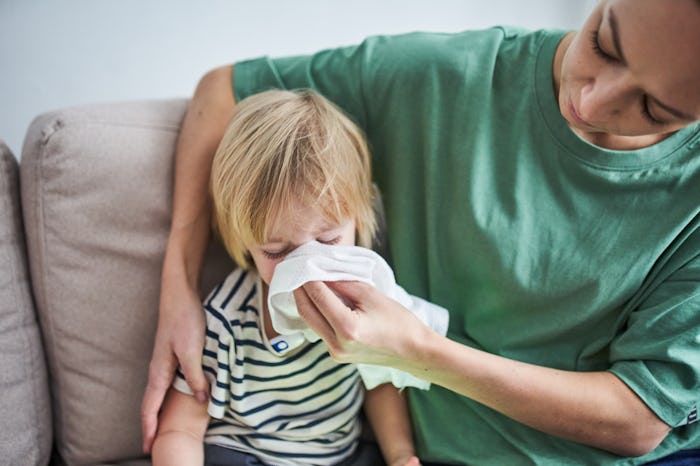Let's Boogie

How To Teach Your Toddler To Blow Their Nose & What Age To Start
You’ll need tissues and maybe feathers.
When your baby or toddler is congested, it can be pretty pitiful. There aren’t safe decongestant medications for really young children, so you’re left with snot suckers, saline spray, and sitting in a steamy bathroom while the hot water runs in the shower. But as your little one grows up and starts getting their bearings, you’re going to want to know how to teach your toddler to blow their nose. Like most skills — like tying their own shoes, for example — when your child will be ready to learn to blow their nose depends on their development. Here’s how to tell when they’re ready, and how to get started on the tissue training.
At what age can you teach a toddler to blow their nose?
Like any developmental milestone, when your child is ready to learn this snotty skill may vary. Anytime after they turn 2 is fair game to try teaching them.
“For a typically developing child, some may be ready as early as age 2, but it's not uncommon for it to take until 3, 4, or even 5 years old to become skilled at blowing your nose,” says Dr. Kitty O’Hare, M.D., FAAP, senior medical director for pediatrics at Duke Primary Care. “Children with special healthcare needs who are developing a little differently may take longer.”
How to teach a toddler to blow their nose
You’ll want to practice blowing air out of the nose before your child gets sick, O’Hare says. They’re a lot more likely to follow along when they’re not feeling crummy. Other than that piece of advice, O’Hare says teaching your kid to blow their noise is all about making it fun. Find a way to make a game of blowing air out of their nose, and the rest will fall into place. O’Hare recommends these methods:
- Lay a feather or small scrap of paper on a low table. Tell your little one to move it around by blowing out through their nose.
- Show them how to use their nose when pretending to be an animal, like a charging rhinoceros or a fire-breathing dragon.
- Try coaching them through how to blow bubbles with their nose in the bathtub.
- Pretend to blow out a birthday candle, but using only their nose.
- Teach them not to blow too terribly hard, lest they hurt their nose.
On Reddit, one parent recommends holding a tissue in front of your child. Let them practice blowing air through their mouth to move it, and then challenge them do the same, but by blowing through their nose only. Any way you can make learning the skill more fun is worth a shot. You should be wary, however, of any tips online that encourage you to put things (like little balls of tissue) in your child’s nostrils for them to blow out.
“I probably wouldn't recommend that,” O’Hare says. “We teach kids not to put things in their nose, not to put small toys or other things in their nose, not to pick their nose, and we wouldn't want to have them get too used to putting something inside their nose.”
“The tricks that I wouldn’t recommend doing are any tricks that involve sticking anything into the nostrils. This can lead to foreign bodies getting stuck inside the nose,” says Dr. Peily Soong, M.D., a pediatrician at Children’s of Alabama.
Once your toddler gets the hang of it, you can try teaching them to hold up the tissue and press on one nostril at a time to clear out each side of their nose. If they like boogers, this part should be rewarding for them. But what if they’re just not getting the hang of it?
“I think of it somewhat like toilet training. If your child is engaged and playing along and you're smiling and praising them and they're enjoying the activity, they may pick it up a little bit faster, but not every child is ready to toilet train at the same time, or at the same pace. If they just don't seem to be getting it, or it's frustrating you or them, just take a break and come back to it at another time,” O’Hare says.
You can keep trying as long as you and your child are willing, Soong says. When either party gets frustrated, call off the training games and try again in a month or so.
Tips for dealing with congestion in toddlers
Whether or not your little one can blow all the boogers out of their nose, O’Hare says there are some things you can do to help clear their sinuses. First, don’t give them any medications without running them by your pediatrician beforehand.
“Many over-the-counter medications are not safe for young children, even if they're labeled organic or all-natural,” she says. “But there are some non-medicine things that help a lot. One is to get a simple bottle of spray saline, or you can mix up some yourself at home and use little squirts of salt water in each side of the nose. That helps to loosen up the mucus, and makes it a little easier for the mucus to come out. Using a humidifier at the child's bedside at night or while they're sitting still, playing, or watching a video can help as well.”
So, happy feather-puffing, rhinoceros huffing, nose blowing training. Aside from the snot blasting here and there while your little one learns to blow their nose, the process actually sounds pretty fun.
Expert:
Dr. Kitty O’Hare, M.D., FAAP, senior medical director for pediatrics at Duke Primary Care
Dr. Peily Soong, M.D., a pediatrician at Children’s of Alabama
This article was originally published on